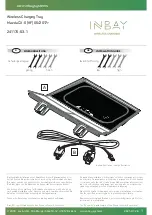
TE Series
Digital Solid State Soft Starters 18 – 1250A
66
Appendix 1 - Ramp Profile Details
The
TE Series
offers four different types of starting ramp profiles.
Simply select the one that best matches your motor / load requirements.
In addition,
two separate ramps
are available that can be selected via
contact closure (see section 4.2.5.a), and each one can be set up for
any ramp type as shown in the table below.
Following are descriptions of the four types of Ramp Profiles
1. Voltage Ramping
is the most reliable starting method, since at some
point the starter will reach an output voltage high enough to allow the
motor to draw full current and develop full torque. This method is useful
for applications where the load conditions change frequently and
significantly enough to require different levels of starting torque.
Examples where this is effective are:
Material handling conveyers
Positive displacement pumps
Drum mixers, grinders etc.
Voltage is increased from a starting point (Initial Torque) to full voltage
over an adjustable time period (Ramp Time). To achieve Voltage
Ramping, set the Ramp Profile (F010) to 0001 or 0003 (Voltage Ramp),
and the Maximum Current Limit setting (F014) to maximum (600%).
Since this is essentially Locked Rotor Current on most motors, there will
be little or no Current Limit effect on the Ramp profile. Initial Torque
setting comes from the Initial Voltage function F011.
2. Voltage Ramping with Current Limit
works similarly to the above,
except adds an adjustable maximum current output. Voltage is
increased gradually until the Maximum Current Limit setting (F014) is
reached, then held at this level until the motor accelerates to full speed.
Then as the current drops below the limit setting, voltage is
automatically increased to maximize torque until the
TE Series
is At-
Speed. This may be necessary in applications where the electrical
power is limited. Examples would be:
Portable or emergency generator supplies
Utility power near the end of a transmission line or other starting
power demand restrictions.
Using Current Limit will override the Ramp Time setting if necessary, so
use this feature when acceleration time is not critical. The Ramp Time
setting however still determines the slope of the ramp up to the Current
Limit setting to apply the softest possible acceleration. To achieve
Voltage Ramping with Current Limit, set the Ramp Profile (F010) to
0001 or 0003 (Voltage Ramp), and the Maximum Current Limit setting
(F014) to a desired lower setting, as determined by your application
requirements.
R
R
a
a
m
m
p
p
1
1
S
S
e
e
t
t
t
t
i
i
n
n
g
g
s
s
“Ramp Type
Selection”
from F010
Ramp 2 Settings
R
R
a
a
m
m
p
p
T
T
y
y
p
p
e
e
I
I
n
n
i
i
t
t
i
i
a
a
l
l
T
T
o
o
r
r
q
q
u
u
e
e
f
f
r
r
o
o
m
m
…
…
R
R
a
a
m
m
p
p
T
T
i
i
m
m
e
e
f
f
r
r
o
o
m
m
…
…
C
C
u
u
r
r
r
r
e
e
n
n
t
t
L
L
i
i
m
m
i
i
t
t
f
f
r
r
o
o
m
m
…
…
Ramp
Type
Initial
Torque
from…
Ramp
Time
from…
Current
Limit
from…
Voltage
F011 F013 F014
1
Voltage
F015 F017 F018
Current
F012 F013 F014
2
Current
F016 F017 F018
Voltage
F011 F013 F014
3
Current
F016 F017 F018
Current
F012 F013 F014
4
Voltage
F015 F017 F018
Table APP 1.1: Ramp Selection Choices and Settings
Initial Torque
Full Speed
Vo
lt
a
g
e
Time
Figure APP 1.2:
Voltage Ramp with Current Limit
Ramp Time
Current
Limit Setting
Initial Torque
Full Speed
Vo
lt
a
g
e
Time
Figure APP 1.1:
Voltage Ramp w/o Current Limit
Ramp Time
















































